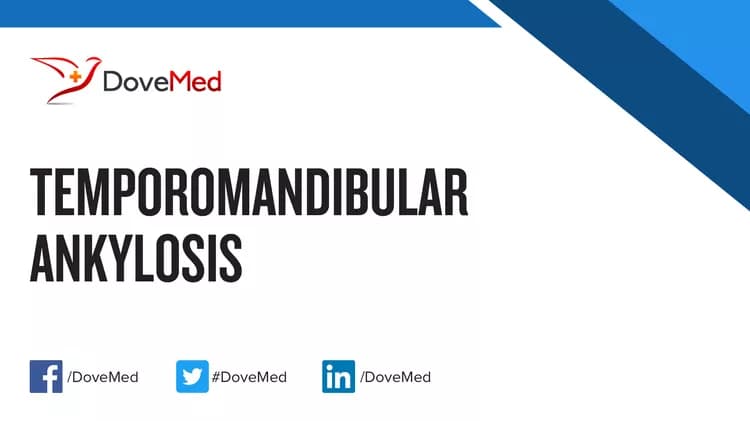What are the other Names for this Condition? (Also known as/Synonyms)
- Ankylosis of the Temporomandibular Joint
- Ankylosis of the TMJ
- TMJ Ankylosis
What is Temporomandibular Ankylosis? (Definition/Background Information)
- Temporomandibular Ankylosis is a condition that occurs when the temporomandibular joint (the joint that connects the jaw to the side of the head) becomes fused by bony or fibrous tissue
- As a result, affected people may experience pain, speech impairment, and difficulty chewing and swallowing. It can interfere with nutrition, oral hygiene and the normal growth of the face and/or jaw
- Although the condition can be diagnosed in people of all ages, it generally occurs during the first and second decades of life
- Temporomandibular Ankylosis is most commonly caused by trauma or infection; it may also be associated with certain conditions such as ankylosing spondylitis, rheumatoid arthritis, or psoriasis
- The condition is typically treated surgically
(Source: Temporomandibular Ankylosis; Genetic and Rare Disease Information Center (GARD) of National Center for Advancing Translational Science (NCATS), USA.)
Who gets Temporomandibular Ankylosis? (Age and Sex Distribution)
- Temporomandibular Ankylosis is a rare disorder affecting the jaw
- The presentation of symptoms may occur at any age. However, most cases occur before age 20 years
- Both males and females may be affected
- Worldwide, individuals of all racial and ethnic groups may be affected
What are the Risk Factors for Temporomandibular Ankylosis? (Predisposing Factors)
The risk factors for Temporomandibular Ankylosis may include:
- Trauma to the jaw
- Infection
- Certain pre-existing conditions such as ankylosing spondylitis, rheumatoid arthritis, or psoriasis
It is important to note that having a risk factor does not mean that one will get the condition. A risk factor increases one’s chances of getting a condition compared to an individual without the risk factors. Some risk factors are more important than others.
Also, not having a risk factor does not mean that an individual will not get the condition. It is always important to discuss the effect of risk factors with your healthcare provider.
What are the Causes of Temporomandibular Ankylosis? (Etiology)
- In most cases, Temporomandibular Ankylosis is caused by trauma or infection to the temporomandibular joint
- In some cases, , Temporomandibular Ankylosis may be a manifestation of certain other medical conditions, such as ankylosing spondylitis, rheumatoid arthritis, or psoriasis
What are the Signs and Symptoms of Temporomandibular Ankylosis?
The signs and symptoms of Temporomandibular Ankylosis may include:
- Jaw pain
- Problems with chewing and/or swallowing
- Inability to open jaw completely
- Facial dysmorphism
- Speech impediment
How is Temporomandibular Ankylosis Diagnosed?
Temporomandibular Ankylosis is diagnosed on the basis of the following information:
- Complete physical examination
- Thorough medical history evaluation
- Assessment of signs and symptoms
- Laboratory tests
- Imaging studies
- Biopsy studies, if necessary
Many clinical conditions may have similar signs and symptoms. Your healthcare provider may perform additional tests to rule out other clinical conditions to arrive at a definitive diagnosis.
What are the possible Complications of Temporomandibular Ankylosis?
The complications of Temporomandibular Ankylosis may include:
- Severe pain
- Malnutrition
- Negative impact on oral hygiene
- Embarrassment and depression
Complications may occur with or without treatment, and in some cases, due to treatment also.
How is Temporomandibular Ankylosis Treated?
Typically, the treatment for Temporomandibular Ankylosis is surgery, to correct the malformation of the bony tissue in the jaw joint(s).
How can Temporomandibular Ankylosis be Prevented?
- It may be possible to prevent Temporomandibular Ankylosis by avoiding trauma to the facial region and seeking immediate medical attention for infections or pre-existing conditions that are known to cause TMJ Ankylosis
- Regular medical screening at periodic intervals with tests and physical examinations are recommended
What is the Prognosis of Temporomandibular Ankylosis? (Outcomes/Resolutions)
- The prognosis of Temporomandibular Ankylosis is dependent upon the severity of the signs and symptoms and associated complications, if any
- Individuals with mild conditions have better prognosis than those with severe symptoms and complications
- Typically, the prognosis may be assessed on a case-by-case basis
Additional and Relevant Useful Information for Temporomandibular Ankylosis:
The following DoveMed website link is a useful resource for additional information:
Related Articles
Test Your Knowledge
Asked by users
Related Centers
Related Specialties
Related Physicians
Related Procedures
Related Resources
Join DoveHubs
and connect with fellow professionals


0 Comments
Please log in to post a comment.